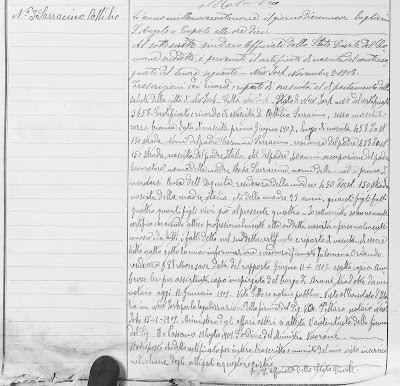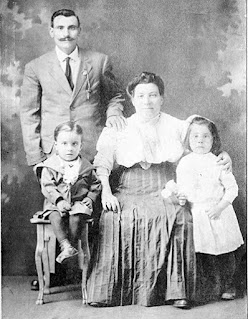If you've been at this genealogy business for a while, you've learned a lot about your ancestors.
You've gathered tons of facts—births, marriages, deaths—and piled up a bunch of evidence. You've got ship manifests for your immigrant ancestors. Census records for everyone born before 1940. You've got birth records for forgotten relatives.
So much material that no one else in your family knew!
How are you sharing all this family history with your relatives?
About 10 years ago, I was still fairly new to family tree research. One cousin encouraged me to create a large-format tree to share with my fellow Saviano and Sarracino descendants. I told her, "I've got so much more to find!" She said, "There will always be more to find, but you need to share what you have."
I created a 2-foot by 6-foot family tree starting with my 3rd great grandparents. It goes all the way down to the present day (as of 2007 or so). I went to Fedex Kinko's to have 40 copies printed, which I gave to the heads of the many families on the tree.
 |
| Your family research is never done. That doesn't mean you can't share it now. |
At that point, everyone in the family knew about my hobby. I became the go-to family historian.
But that big poster was all I ever created and shared. And it is barely the tip of the tip of the iceberg.
What about the rest of it? How do I share with my relatives the fact that our shared ancestor moved several towns away to marry. Then he moved to the next town, where our great uncle was born. Then he went back to his hometown. And finally he came to America with his entire family.
How do I let my father's side of the family know that our great grandfather and his brother married our great grandmother and her sister? How do I show them the many trips our great grandfather made to America before retiring in Italy? (See "
Great Grandpa Was a Bird of Passage".)
Giving your relatives access to your online tree isn't good enough. We might love that pedigree view, but where are the stories? Where is my particular grandfather's timeline?
As genealogists, we all have an obligation to document our work in meaningful ways. We must share that documentation with our cousins, aunts and uncles, siblings, and more distant relatives.
What to Share
No matter what format you use, you need to create family history books. First divide up your family into logical groups, such as:
- your mother's mother's relatives
- your mother's father's relatives
- your father's mother's relatives
- your father's father's relatives
If your large family demands more subsets than these, spell those out, too. But each of your grandparents is a great place to start.
There will be some overlap. My first cousins—my mother's sister's children—are as interested in our grandmother as our grandfather. So they will want two of my books. But my second cousins have no relation to my maternal grandfather. It's the other book they'll want.
In my case, my other first cousins—my father's sister's children—get only one book. Why? Because our shared grandparents were third cousins. It doesn't make sense to make two books out of what's ultimately one family.
Try thinking of your family story like a Hollywood movie. My two grandfathers came from neighboring Italian towns and wound up living one block apart in the Bronx, New York. What a great coincidence! Unknowing neighbors in Italy, their children attended the same school in the Bronx and later married one another.
That would be a great movie story of parallel lives finally uniting. That's a story to tell in chronological order.
Now consider what you'd like to include in each book. Here are some ideas:
- Standard genealogy charts and reports—family group sheets and small trees, such as the parents and many siblings of your grandmother
- Vital records—images of the birth, marriage, and death records you've found, and the facts from the documents you don't have in paper or image form
- Timelines—focus on a specific individual and list his major life events in a timeline format. Include some historical facts to give more meaning to his life. For instance, I'll want to mention the start of World War I because of its profound effect on my grandfather.
- Immigration records—ship manifests and naturalization papers. If you're lucky, you may have a passport photo to share.
- Stories—either summarize parts of an individual's life in narrative form, or share an in-depth story that fascinates you
- Photos—your relatives may love seeing a family tombstone as much as you do. Include old family photos that some relatives haven't seen.
- Sources—include footnotes documenting the source of your facts. A generation from now, a young relative who wants to continue your work will bless you for eternity.
- Table of contents and index—your relatives will keep your book and look at it now and again. Make it easy to find exactly what they want to find. Tip: Word and other software can create a table of contents and index automatically.
How to Create the Book
If you aren't using family tree software, this is going to be a big job. But if you are using family tree software or you have your tree on a genealogy website like Ancestry or FamilySearch, things are easier.
After deciding which books you need to create, find a central figure—a hero—for your story. For instance, in my maternal grandmother's book, I would focus on her maternal grandfather. He was my first ancestor to leave Italy and come to America. He's a ground-breaker. Our lives all changed with his decision.
With your central figure chosen, create a large tree of that person's ancestors and descendants. Or create trees of smaller groupings, such as his direct ancestors and only his children.
Create trees that will give the most value to the relatives you want to share your book with.
Now gather your documents for this person: birth, marriage, immigration, census, death, and so on.
Examine your family tree's facts and documents for this person. As you write out their timeline of events, do any stories come to life?
Does research tell you they emigrated due to religious or political persecution? Was there an earthquake that destroyed their town?
Have you discovered your ancestor's first marriage and other children you never knew about? There's an interesting story!
Your family tree software may have the ability to create a book with the pieces you've assembled. If not, you can put those pieces together in Word or a desktop publishing program.
Anything you can digitize—documents, trees, stories, even video or audio recordings—you can include in a Word document.
How to Share the Book
If your document doesn't contain any video or audio, consider having it printed at a local shop or a large store like Staples. You can copy your big book file to a flash drive or CD-ROM and bring it to a store for printing.
Several online services will turn your work into a hard-covered book.
This is not an endorsement, but if you go to
Bookemon.com, you can view sample family history books. You can borrow ideas from their contents and layouts. They also have inexpensive templates and a book price calculator.
You know how I didn't want to print my family tree 10 years ago because I'd only just begun? That's the beauty of a strictly digital family history book.
You can update, correct, and add to the book at any time. Then give your relatives a link to the "latest edition".
Look at you! You're a genealogist, an author, and a publisher!
These articles should help you along:








